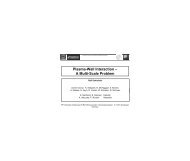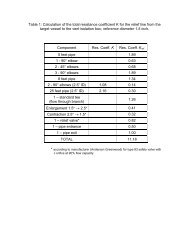Search for a Neutron Electric Dipole Moment at the SNS
Search for a Neutron Electric Dipole Moment at the SNS
Search for a Neutron Electric Dipole Moment at the SNS
You also want an ePaper? Increase the reach of your titles
YUMPU automatically turns print PDFs into web optimized ePapers that Google loves.
<strong>Search</strong> <strong>for</strong> a <strong>Neutron</strong> <strong>Electric</strong> <strong>Dipole</strong> <strong>Moment</strong> <strong>at</strong> <strong>the</strong> <strong>SNS</strong>Brad Filippone (Caltech), Martin Cooper (LANL), Paul Huffman (NC St<strong>at</strong>e)<strong>for</strong> <strong>the</strong> nEDM@<strong>SNS</strong> Collabor<strong>at</strong>ionThe discovery of a neutron EDM (<strong>Electric</strong> <strong>Dipole</strong> <strong>Moment</strong>) above <strong>the</strong> Standard Model background,which lies about five orders of magnitude below <strong>the</strong> present limits, would be <strong>the</strong> first evidence <strong>for</strong> a newtype of time-reversal viol<strong>at</strong>ion (and, hence, CP viol<strong>at</strong>ion via <strong>the</strong> CPT <strong>the</strong>orem). Sakharov [1] explained <strong>the</strong>connection between such a viol<strong>at</strong>ion and <strong>the</strong> empirical fact th<strong>at</strong> m<strong>at</strong>ter exists in our universe. Experimentshave searched <strong>for</strong> a neutron EDM <strong>for</strong> over six decades, during which time <strong>the</strong> sensitivity has improvedby nearly eight orders of magnitude. Failure to observe a non-zero EDM has severely constrained manydifferent versions of beyond-Standard-Model physics, including minimal supersymmetry (e.g. MSSM).The 2011 Fundamental <strong>Neutron</strong> Physics NSAC (Kumar) report [2] reiter<strong>at</strong>ed <strong>the</strong> scientific motiv<strong>at</strong>ion<strong>for</strong> EDM searches, saying <strong>the</strong>y remain as compelling as ever. This search will challenge <strong>the</strong>ories <strong>for</strong> physicsbeyond <strong>the</strong> Standard Model (SM) and <strong>the</strong> weak baryogenesis hypo<strong>the</strong>sis regarding <strong>the</strong> baryon asymmetryof <strong>the</strong> universe. The known CP-viol<strong>at</strong>ion in <strong>the</strong> SM remains insufficient by many orders of magnitude toexplain <strong>the</strong> l<strong>at</strong>ter, leaving a window of discovery <strong>for</strong> non-SM CP-viol<strong>at</strong>ion, and making <strong>the</strong> search <strong>for</strong> newsources of CP-viol<strong>at</strong>ion essential. The Kumar report st<strong>at</strong>ed th<strong>at</strong> a measurement of <strong>the</strong> neutron EDM withsensitivity <strong>at</strong> <strong>the</strong> ultim<strong>at</strong>e reach of <strong>the</strong> nEDM@<strong>SNS</strong> experiment would have a profound impact on nuclearphysics, particle physics and cosmology, even in <strong>the</strong> event of a neg<strong>at</strong>ive result, and deemed this to be <strong>the</strong>initi<strong>at</strong>ive with <strong>the</strong> highest scientific priority in US neutron science [2]. In <strong>the</strong>ir words, “A non-zero EDMwould constitute a truly revolutionary discovery.”Since <strong>the</strong> last long range plan, <strong>the</strong> most important EDM results have been <strong>the</strong> new limit <strong>for</strong> 199 Hgof 0.3 × 10 −28 e·cm [3] and <strong>for</strong> <strong>the</strong> neutron of 300 × 10 −28 e·cm [4]. In <strong>at</strong>omic systems, <strong>the</strong> physics iscomplementary to th<strong>at</strong> of <strong>the</strong> neutron EDM, however <strong>the</strong>re are additional uncertainties due to <strong>the</strong> <strong>at</strong>omic<strong>the</strong>ory of <strong>the</strong> electron screening and enhancement factors. The 199 Hg measurement will be pursued witha goal of ano<strong>the</strong>r factor of ten improvement in precision in <strong>the</strong> next five years, and an additional factorof five after 2020. In order to take advantage of octupole enhancements, promising experiments on 225 Raand 223 Rn are underway th<strong>at</strong> should produce exciting results after 2020.Meanwhile <strong>for</strong> <strong>the</strong> neutron, nine experiments worldwide have begun, <strong>at</strong> least one of which shouldproduce an improvement by a factor of five by 2020. These experiments and <strong>the</strong>ir estim<strong>at</strong>ed reach aresummarized in Table 1. The number of worldwide ef<strong>for</strong>ts to measure <strong>the</strong> neutron EDM illustr<strong>at</strong>es <strong>the</strong>excitement in <strong>the</strong> scientific community to determine this important quantity.The goal of <strong>the</strong> nEDM@<strong>SNS</strong> experiment is to achieve a sensitivity < 3 × 10 −28 e-cm. A conceptualdesign of <strong>the</strong> experiment is shown in Fig. 1. A value (or limit) <strong>for</strong> <strong>the</strong> neutron EDM will be extracted from<strong>the</strong> difference between neutron spin precession frequencies <strong>for</strong> parallel and anti-parallel magnetic (∼ 30mGauss) and electric (∼ 70 kV/cm) fields. This experiment, based on Ref. [5], uses a novel polarized3 He co-magnetometer and will detect <strong>the</strong> neutron precession via <strong>the</strong> spin-dependent neutron capture on3 He. The capture signal is observed via scintill<strong>at</strong>ion light produced from <strong>the</strong> ioniz<strong>at</strong>ion in liquid heliumof <strong>the</strong> energetic proton and triton produced in <strong>the</strong> reaction. Since <strong>the</strong> EDM of 3 He is strongly suppressedby electron screening in <strong>the</strong> <strong>at</strong>om it can be used as a sensitive magnetic field monitor. High densities oftrapped ultra-cold neutrons are produced via phonon production in superfluid 4 He which can also supportlarge electric fields.1
Table 1: Summary of worldwide nEDM searches.Experiment UCN Source Cell Measurement σ dTechnique(10 −28 e·cm)CryoEDM (ILL) Superfluid 4 He 4 He Ramsey technique <strong>for</strong> ω Phase 1 ≈ 50External SQUID magnetometers Phase 2 < 5PNPI (ILL) ILL turbine Vacuum Ramsey technique <strong>for</strong> ω Phase 1 < 100PNPI/Solid D 2 E ⃗ = 0 cell <strong>for</strong> magnetometer Phase 2 < 10Crystal (ILL) Cold neutrons Solid Crystal Diffraction < 100PSI EDM Solid D 2 Vacuum Ramsey technique <strong>for</strong> ω Phase 1 ≈ 50External Cs and 3 He ⃗ magnetometers Phase 2 < 5Possible Hg or Xe comagnetometerMunich FRMII Solid D 2 Vacuum Under construction < 5Similar to PSI EDMnEDM (<strong>SNS</strong>) Superfluid 4 He 4 He 3 He capture <strong>for</strong> ω < 53 He comagnetometersquids & Dressed spinsTRIUMF Superfluid 4 He Vacuum Phase I RCNP < 10JPARC Solid D 2 Vacuum Under development < 5Crystal (NIST) Cold neutrons Solid Under development ≈ 5?Several unique fe<strong>at</strong>ures of <strong>the</strong> nEDM@<strong>SNS</strong> experiment include:• loading <strong>the</strong> neutron trap with UCNs th<strong>at</strong> are produced in 0.45 K liquid He via <strong>the</strong> phonon recoilprocess [6]• using superfluid 4 He as a working medium <strong>for</strong> <strong>the</strong> very high electric field• using a dilute mixture of polarized 3 He in superfluid 4 He as a co-magnetometer because <strong>the</strong> 3 He hasa negligible EDM• using a direct SQUID measurement of <strong>the</strong> precession frequency of <strong>the</strong> 3 He magnetic dipoles• using a superconducting shield to isol<strong>at</strong>e <strong>the</strong> measurement region from external magnetic field fluctu<strong>at</strong>ions• determining <strong>the</strong> difference in <strong>the</strong> neutron and 3 He precession frequencies from <strong>the</strong> spin-dependentabsorption cross section and <strong>the</strong> subsequent vari<strong>at</strong>ions in light intensity from scintill<strong>at</strong>ions in <strong>the</strong> 4 He• allowing two techniques <strong>for</strong> measuring <strong>the</strong> EDM, ei<strong>the</strong>r <strong>the</strong> direct method with SQUIDs or a dressedspinmethod th<strong>at</strong> uses a high-frequency magnetic field to modify <strong>the</strong> effective magnetic moments of<strong>the</strong> two polarized species [7]• providing a comparison measurement of changes in <strong>the</strong> precession frequency of <strong>the</strong> two species underE and/or B field reversal in two measurement cells• using <strong>the</strong> temper<strong>at</strong>ure dependence of <strong>the</strong> geometric phase <strong>for</strong> <strong>the</strong> 3 He to measure this importantsystem<strong>at</strong>ic [8, 9].Control of system<strong>at</strong>ic errors is essential <strong>for</strong> an experiment <strong>at</strong> <strong>the</strong> 10 −28 e·cm level. The differentteams have chosen different approaches, but <strong>the</strong> nEDM@<strong>SNS</strong> experiment has <strong>the</strong> most extensive program<strong>for</strong> estim<strong>at</strong>ing system<strong>at</strong>ic errors. A list of techniques incorpor<strong>at</strong>ed into <strong>the</strong> designs of <strong>the</strong> experimentalapproaches is shown in Table 2.The experiment represents a major technical challenge and requires a team with broad technical knowledgeand extensive experience. The collabor<strong>at</strong>ion, including researchers from twenty-one institutions with2
expertise in nuclear, <strong>at</strong>omic, and low-temper<strong>at</strong>ure physics, is continuing to address critical R&D developmentsin prepar<strong>at</strong>ion <strong>for</strong> construction of a full experiment. Key issues being addressed include:1. Maximum electric field strength <strong>for</strong> large-scale electrodes made of appropri<strong>at</strong>e m<strong>at</strong>erials in superfluidhelium below a temper<strong>at</strong>ure of 1 K.2. Magnetic field uni<strong>for</strong>mity <strong>for</strong> a large-scale magnetic coil and a Pb superconducting magnetic shield.3. Development of co<strong>at</strong>ed measurement cells th<strong>at</strong> preserve neutron and 3 He polariz<strong>at</strong>ion along withneutron storage time.4. Understanding of polarized 3 He injection and transport in <strong>the</strong> superfluid.5. Estim<strong>at</strong>ion of <strong>the</strong> detected light signal from <strong>the</strong> scintill<strong>at</strong>ion in superfluid helium.The experiment will be carried out on <strong>the</strong> Fundamental <strong>Neutron</strong> Physics Beamline (FNPB) <strong>at</strong> OakRidge N<strong>at</strong>ional Labor<strong>at</strong>ory’s Spall<strong>at</strong>ion <strong>Neutron</strong> Source (<strong>SNS</strong>). Construction is likely to take <strong>at</strong> least fiveyears, followed by hardware commissioning and d<strong>at</strong>a taking. Thus first results could be anticip<strong>at</strong>ed by <strong>the</strong>end of <strong>the</strong> decade.Table 2: Comparison of capabilities <strong>for</strong> nEDM searches. Items marked with an ∗ denote a system<strong>at</strong>icsadvantage.Capability Cryo1 Cryo2 PSI2 PSI3 <strong>SNS</strong>∆ω via accumul<strong>at</strong>ed phase in n polariz<strong>at</strong>ion Y Y Y Y N∆ω via light oscill<strong>at</strong>ion in 3 He capture N N N N Y∗ Comagnetometer N N Y Y Y∗ Superconducting B-shield Y Y N N Y∗ Dressed Spin Technique N N N N YHorizontal B-field Y Y N N Y∗ Multiple EDM cells N Y N Y Y∗ Temper<strong>at</strong>ure Dependence of Geo-phase effect N N N N YReferences[1] A. D. Sakharov, J. Exp. Theo. Phys. 5 (1967) 24.[2] K. Kumar, et al., http://science.energy.gov/∼/media/np/nsac/pdf/docs/NSAC<strong>Neutron</strong>Report.pdf(2011).[3] W. C. Griffith, et al., Phys. Rev. Lett. 102 (2009) 101601.[4] C. A. Baker, et al., Phys. Rev. Lett. 97 (2006) 131801.[5] R. Golub, S. K. Lamoreaux, Phys. Rep. 237 (1994) 1.[6] R. Golub, J. M. Pendlebury, Phys. Lett. A 53 (1975) 133.[7] A. Esler, et al., Phys. Rev. C 76 (2007) 051302(R).[8] J. M. Pendlebury, Phys. Rev. A 70 (2004) 032102.[9] S. K. Lamoreaux, R. Golub, Phys. Rev. A 71 (2005) 32104–1.3
Figure 1: Schem<strong>at</strong>ic diagram of <strong>the</strong> nEDM@<strong>SNS</strong> appar<strong>at</strong>us.4


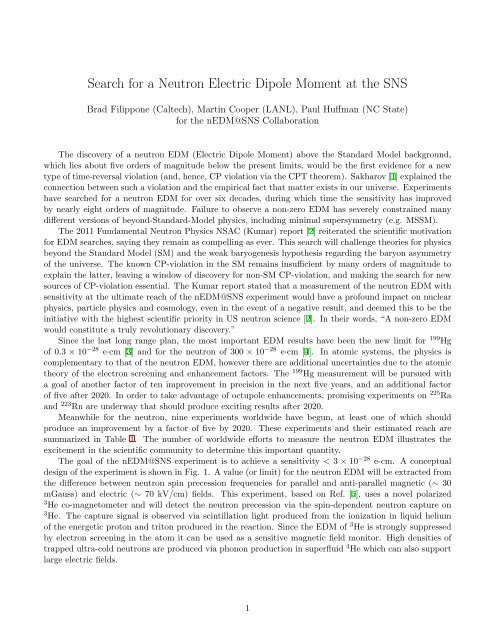
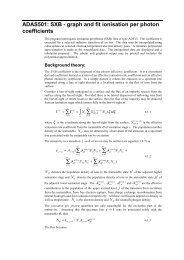
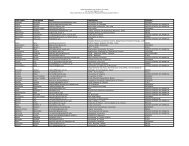
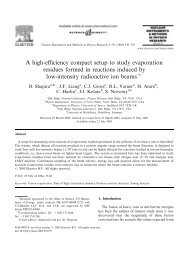
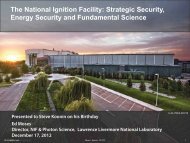

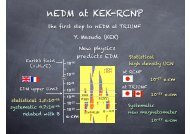
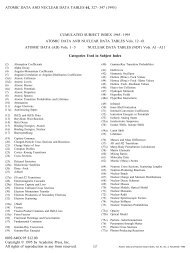


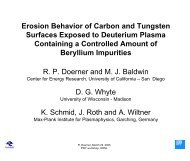
![Mixed-mode Calculations within the Nuclear Shell Model [pdf]](https://img.yumpu.com/28265410/1/190x146/mixed-mode-calculations-within-the-nuclear-shell-model-pdf.jpg?quality=85)
